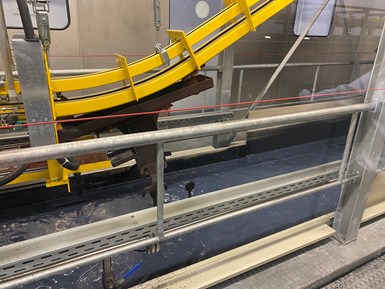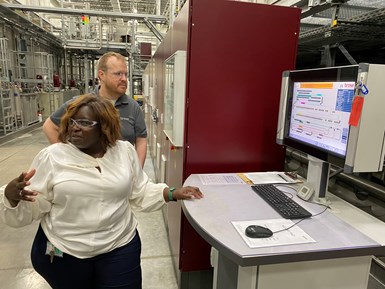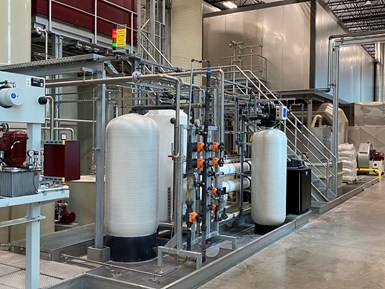
Brose’s New Boston, Michigan facility includes a 1,000 m2 electrocoating line.
Photo Credit: All photos by Products Finishing
When it comes to automotive components, quality, turnaround time and consistency are of utmost importance. These are the necessary hallmarks of companies that supply automotive OEMs.
Brose claims to be the world’s fourth largest family-owned automotive supplier. Serving more than 80 automotive manufacturers, Brose specializes in mechatronic components and systems — which is to say the integration of mechanical, electrical and electronic systems. It supplies systems for vehicle doors and liftgates, electric motors and drives, and seat components to numerous automotive OEMs and tier one suppliers.
Featured Content
For the North American market, Brose has electrocoating lines in New Boston, Michigan, Tuscaloosa, Alabama, Queretaro, Mexico, and London, Canada. The paint lines in London and Tuscaloosa are 500 m2 lines. The New Boston and Queretaro lines are 1,000 m2 lines.

Brose’s New Boston, Mich. line processes 133 racks of parts per hour.
Benjamin Hill is the regional surface technology specialist at Brose and is responsible for maintaining consistency in process and quality across several of the company’s ecoat lines. While the lines aren’t all the same in size, line speeds are adjusted to compensate. Hill explains, “The 1,000 m2 lines are twice as fast and the process tanks are twice as long because they still go through the same 90-second degreaser steps.”
Brose’s plant in New Boston, Michigan, is largely devoted to automobile seat components and develops both power and manual seat structures as well as adjustment systems for both front and rear seats including structures for lumbar support and massage as well as seatbelt mechanisms.
Paint technologist Yolanda Watts oversees the New Boston ecoat facility. Watts got her start with electrocoating during a stint with BASF right out of college. From the beginning, her entire career has been within the automotive sector in some form or another. With experience not only in ecoat, but also topcoats, clear coat, base coat and powder coat, Watts was a natural choice to head up an ecoat line for Brose. Watts got a call from a recruiter during the New Boston line’s installation and has been running the facility’s ecoat operation ever since.
“I was here for the inception of it,” Watts says. “I watched them place the tanks and weld the pipes together.”
Watts takes pride in keeping her line running smoothly. She says, “It is a two-hour process. Every 27 seconds we’re able to load and unload a rack — we can run 133 racks per hour.”
A modular approach

Brose uses color-coding for easy identification of the various processes within each facility.
Brose’s electrocoating line, like everything within the company, is highly organized and optimized for efficiency. Aspects of the line are color-coded for easy identification, fitting within the company’s modular approach.
Watts explains, “We operate under the same standard across all the Brose paint lines. So, our targets for film build thickness, quality and corrosion testing are consistent across all the Brose paint lines. For the most part, the paint racks are standardized across the paint lines. We have two paint lines that have a different type of rack. If there happened to be a part that was being painted here on a certain style of rack, and we ran out of space or time — whatever the case might be — I could send these racks and parts to a sister plant and then they can just pick up exactly where we left off. It wouldn’t be a change, per se, to the customer’s end product.”
This kind of approach is something Brose has implemented across all of operations to ensure consistency in its products.
“It’s very standardized,” Hill says. “We want our customers to feel assurance that whether the part is made in New Boston, Mexico, Czech Republic or China, they’ll get the same quality product.”
Continuous improvement
Despite the standardized approach across the company, the ecoat line in each location is run like its own small business. Watts and Hill both love that sense of ownership and the satisfaction that comes from being able to control all aspects of the ecoat process. Watts equates it to running her own job shop.

Yolanda Watts and Benjamin Hill say a sense of ownership helps drive Brose’s continuous improvement practices.
“I almost run a small separate company within a company — that’s how I view it,” Watts says. “Because it’s not only ecoat. I oversee the pretreat and waste treatment. In the larger world —the OEM market — all of those would be separate, run by separate technologists, separate people, separate managers.”
Watts says this ownership is what allows her to keep the ecoat line optimized and running to Brose’s strict standards.
“I basically run a small business, from interviewing and hiring, to training to payroll to ordering chemicals,” she says.
Hill echoes Watts’ philosophy about how each location is run. Before assuming his regional role, he oversaw the company’s Tuscaloosa paint line and says that sense of ownership is a large part of how Brose drives its improvement practices.
Hill adds, “Part of that entrepreneurship is the fact that we really believe in continuous improvement. We’re always looking for ways that we can improve it, make the process more cost-efficient, make things easier for the pain technicians, and make a better product.”

Wastewater treatment is just one of the areas Brose constantly evaluates for continuous improvement opportunities.
Currently, Watts is exploring ways to improve her line’s rinse water waste treatment system. She is looking to the company’s Taichang, China line as an example.
Hill says sharing continuous improvement successes across locations is a common practice for Brose.
“Because we have a global footprint, we then share that knowledge,” he says. “So, if Yolanda’s next goal is to eliminate lime from her rinse waste process and she’s successful in doing that, she can share the method that she used with the other plants and they can review it to see if it fits their environmental requirements as well. We’re really big into that.”
RELATED CONTENT
-
Applications Innovation Leads to Better Masking Solutions
When masking product failures are costing you money, it pays to work with an expert that can select or engineer the most efficient solution.
-
What is Electrocoating?
E-coat can produce uniform finishes with excellent coverage and outstanding corrosion resistance.
-
8 Things You Need to Know About Paint Booth Lighting
Global Finishing Solutions has come up with some helpful insights on lighting for paints booths which plays a crucial role in achieving a quality paint job.




















